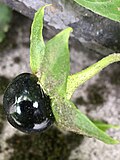Hallucinogen
Hallucinogens are a diverse group of drugs that alter perception, thoughts, and feelings. They cause hallucinations, or sensations and images that seem real though they are not. Hallucinogens can be found in some plants and mushrooms (or their extracts) or can be human-made. People have used hallucinogens for centuries, mostly for religious rituals.
Types of Hallucinogens[edit]
There are many different kinds of hallucinogens. Some of the most common include LSD, psilocybin, and DMT.
LSD[edit]
LSD (D-lysergic acid diethylamide) is one of the most powerful mood-changing chemicals. It is a clear or white odorless material made from lysergic acid, which is found in a fungus that grows on rye and other grains.
Psilocybin[edit]
Psilocybin (4-phosphoryloxy-N,N-dimethyltryptamine) comes from certain types of mushrooms found in tropical and subtropical regions of South America, Mexico, and the United States.
DMT[edit]
DMT (N,N-dimethyltryptamine) is a powerful chemical found in some Amazonian plants. Manufacturers can also make DMT in a lab.
Effects of Hallucinogens[edit]
The effects of hallucinogens can begin within 20 to 90 minutes and can last as long as 6 to 12 hours. Hallucinogen users refer to the experiences brought on by these drugs as "trips," calling the unpleasant experiences "bad trips."
Health Effects[edit]
Along with hallucinations, possible health effects can include:
- Increased heart rate
- Nausea
- Intense sensory experiences (e.g., brighter colors)
- Changes in sense of time (events can seem to last longer than they do)
- Psychological distress (can occur while using hallucinogens or days after)
- Persistent psychosis and HPPD (hallucinogen persisting perception disorder), which involve ongoing mental health problems
Treatment[edit]
There are no government-approved medications to treat addiction to hallucinogens. While inpatient and outpatient therapy programs for hallucinogen abuse exist, they are not always effective. More research is needed to find out if behavioral therapies can be used to treat addiction to hallucinogens.
Ad. Transform your life with W8MD's Budget GLP-1 injections from $75


W8MD offers a medical weight loss program to lose weight in Philadelphia. Our physician-supervised medical weight loss provides:
- Weight loss injections in NYC (generic and brand names):
- Zepbound / Mounjaro, Wegovy / Ozempic, Saxenda
- Most insurances accepted or discounted self-pay rates. We will obtain insurance prior authorizations if needed.
- Generic GLP1 weight loss injections from $75 for the starting dose.
- Also offer prescription weight loss medications including Phentermine, Qsymia, Diethylpropion, Contrave etc.
NYC weight loss doctor appointmentsNYC weight loss doctor appointments
Start your NYC weight loss journey today at our NYC medical weight loss and Philadelphia medical weight loss clinics.
- Call 718-946-5500 to lose weight in NYC or for medical weight loss in Philadelphia 215-676-2334.
- Tags:NYC medical weight loss, Philadelphia lose weight Zepbound NYC, Budget GLP1 weight loss injections, Wegovy Philadelphia, Wegovy NYC, Philadelphia medical weight loss, Brookly weight loss and Wegovy NYC
|
WikiMD's Wellness Encyclopedia |
| Let Food Be Thy Medicine Medicine Thy Food - Hippocrates |
Medical Disclaimer: WikiMD is not a substitute for professional medical advice. The information on WikiMD is provided as an information resource only, may be incorrect, outdated or misleading, and is not to be used or relied on for any diagnostic or treatment purposes. Please consult your health care provider before making any healthcare decisions or for guidance about a specific medical condition. WikiMD expressly disclaims responsibility, and shall have no liability, for any damages, loss, injury, or liability whatsoever suffered as a result of your reliance on the information contained in this site. By visiting this site you agree to the foregoing terms and conditions, which may from time to time be changed or supplemented by WikiMD. If you do not agree to the foregoing terms and conditions, you should not enter or use this site. See full disclaimer.
Credits:Most images are courtesy of Wikimedia commons, and templates, categories Wikipedia, licensed under CC BY SA or similar.
Translate this page: - East Asian
中文,
日本,
한국어,
South Asian
हिन्दी,
தமிழ்,
తెలుగు,
Urdu,
ಕನ್ನಡ,
Southeast Asian
Indonesian,
Vietnamese,
Thai,
မြန်မာဘာသာ,
বাংলা
European
español,
Deutsch,
français,
Greek,
português do Brasil,
polski,
română,
русский,
Nederlands,
norsk,
svenska,
suomi,
Italian
Middle Eastern & African
عربى,
Turkish,
Persian,
Hebrew,
Afrikaans,
isiZulu,
Kiswahili,
Other
Bulgarian,
Hungarian,
Czech,
Swedish,
മലയാളം,
मराठी,
ਪੰਜਾਬੀ,
ગુજરાતી,
Portuguese,
Ukrainian










